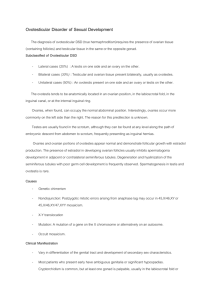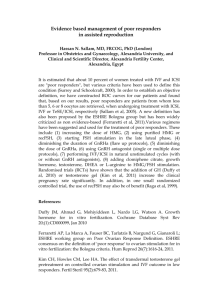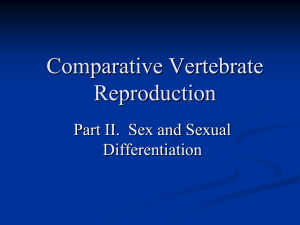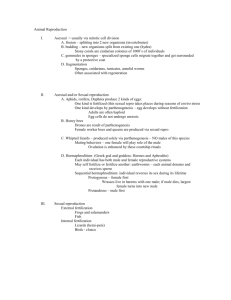A Reliable Endocrine Test with Human Menopausal Gonadotropins
advertisement
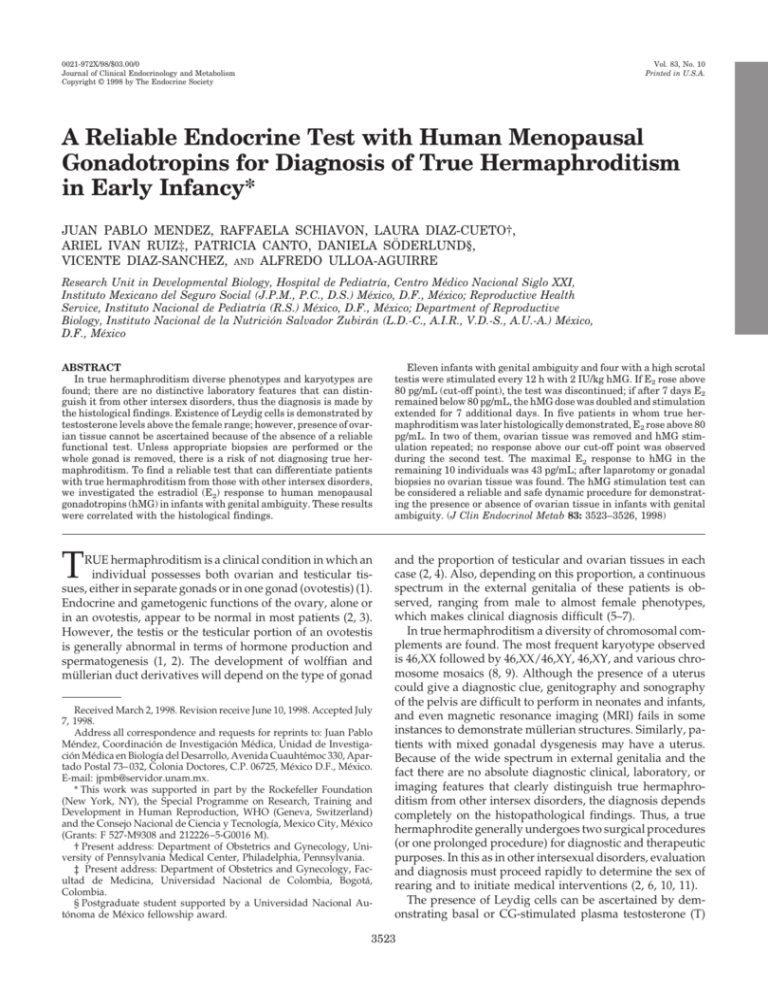
0021-972X/98/$03.00/0 Journal of Clinical Endocrinology and Metabolism Copyright © 1998 by The Endocrine Society Vol. 83, No. 10 Printed in U.S.A. A Reliable Endocrine Test with Human Menopausal Gonadotropins for Diagnosis of True Hermaphroditism in Early Infancy* JUAN PABLO MENDEZ, RAFFAELA SCHIAVON, LAURA DIAZ-CUETO†, ARIEL IVAN RUIZ‡, PATRICIA CANTO, DANIELA SÖDERLUND§, VICENTE DIAZ-SANCHEZ, AND ALFREDO ULLOA-AGUIRRE Research Unit in Developmental Biology, Hospital de Pediatrı́a, Centro Médico Nacional Siglo XXI, Instituto Mexicano del Seguro Social (J.P.M., P.C., D.S.) México, D.F., México; Reproductive Health Service, Instituto Nacional de Pediatrı́a (R.S.) México, D.F., México; Department of Reproductive Biology, Instituto Nacional de la Nutrición Salvador Zubirán (L.D.-C., A.I.R., V.D.-S., A.U.-A.) México, D.F., México ABSTRACT In true hermaphroditism diverse phenotypes and karyotypes are found; there are no distinctive laboratory features that can distinguish it from other intersex disorders, thus the diagnosis is made by the histological findings. Existence of Leydig cells is demonstrated by testosterone levels above the female range; however, presence of ovarian tissue cannot be ascertained because of the absence of a reliable functional test. Unless appropriate biopsies are performed or the whole gonad is removed, there is a risk of not diagnosing true hermaphroditism. To find a reliable test that can differentiate patients with true hermaphroditism from those with other intersex disorders, we investigated the estradiol (E2) response to human menopausal gonadotropins (hMG) in infants with genital ambiguity. These results were correlated with the histological findings. T RUE hermaphroditism is a clinical condition in which an individual possesses both ovarian and testicular tissues, either in separate gonads or in one gonad (ovotestis) (1). Endocrine and gametogenic functions of the ovary, alone or in an ovotestis, appear to be normal in most patients (2, 3). However, the testis or the testicular portion of an ovotestis is generally abnormal in terms of hormone production and spermatogenesis (1, 2). The development of wolffian and müllerian duct derivatives will depend on the type of gonad Received March 2, 1998. Revision receive June 10, 1998. Accepted July 7, 1998. Address all correspondence and requests for reprints to: Juan Pablo Méndez, Coordinación de Investigación Médica, Unidad de Investigación Médica en Biologı́a del Desarrollo, Avenida Cuauhtémoc 330, Apartado Postal 73– 032, Colonia Doctores, C.P. 06725, México D.F., México. E-mail: jpmb@servidor.unam.mx. * This work was supported in part by the Rockefeller Foundation (New York, NY), the Special Programme on Research, Training and Development in Human Reproduction, WHO (Geneva, Switzerland) and the Consejo Nacional de Ciencia y Tecnologı́a, Mexico City, México (Grants: F 527-M9308 and 212226 –5-G0016 M). † Present address: Department of Obstetrics and Gynecology, University of Pennsylvania Medical Center, Philadelphia, Pennsylvania. ‡ Present address: Department of Obstetrics and Gynecology, Facultad de Medicina, Universidad Nacional de Colombia, Bogotá, Colombia. § Postgraduate student supported by a Universidad Nacional Autónoma de México fellowship award. Eleven infants with genital ambiguity and four with a high scrotal testis were stimulated every 12 h with 2 IU/kg hMG. If E2 rose above 80 pg/mL (cut-off point), the test was discontinued; if after 7 days E2 remained below 80 pg/mL, the hMG dose was doubled and stimulation extended for 7 additional days. In five patients in whom true hermaphroditism was later histologically demonstrated, E2 rose above 80 pg/mL. In two of them, ovarian tissue was removed and hMG stimulation repeated; no response above our cut-off point was observed during the second test. The maximal E2 response to hMG in the remaining 10 individuals was 43 pg/mL; after laparotomy or gonadal biopsies no ovarian tissue was found. The hMG stimulation test can be considered a reliable and safe dynamic procedure for demonstrating the presence or absence of ovarian tissue in infants with genital ambiguity. (J Clin Endocrinol Metab 83: 3523–3526, 1998) and the proportion of testicular and ovarian tissues in each case (2, 4). Also, depending on this proportion, a continuous spectrum in the external genitalia of these patients is observed, ranging from male to almost female phenotypes, which makes clinical diagnosis difficult (5–7). In true hermaphroditism a diversity of chromosomal complements are found. The most frequent karyotype observed is 46,XX followed by 46,XX/46,XY, 46,XY, and various chromosome mosaics (8, 9). Although the presence of a uterus could give a diagnostic clue, genitography and sonography of the pelvis are difficult to perform in neonates and infants, and even magnetic resonance imaging (MRI) fails in some instances to demonstrate müllerian structures. Similarly, patients with mixed gonadal dysgenesis may have a uterus. Because of the wide spectrum in external genitalia and the fact there are no absolute diagnostic clinical, laboratory, or imaging features that clearly distinguish true hermaphroditism from other intersex disorders, the diagnosis depends completely on the histopathological findings. Thus, a true hermaphrodite generally undergoes two surgical procedures (or one prolonged procedure) for diagnostic and therapeutic purposes. In this as in other intersexual disorders, evaluation and diagnosis must proceed rapidly to determine the sex of rearing and to initiate medical interventions (2, 6, 10, 11). The presence of Leydig cells can be ascertained by demonstrating basal or CG-stimulated plasma testosterone (T) 3523 3524 JCE & M • 1998 Vol 83 • No 10 MENDEZ ET AL. levels above the female range (6); however, the existence of ovarian tissue before surgery cannot be demonstrated because of the absence of a reliable functional test. Unless appropriate biopsies are performed or the whole gonad is removed, there is a risk of not, even after laparotomy, diagnosing true hermaphroditism. To find a reliable endocrinological test that could differentiate those patients with true hermaphroditism from those with other intersex disorders, we undertook the present study to investigate estradiol (E2) response to human menopausal gonadotropins (hMG) in infants with genital ambiguity. The results of this dynamic test were then correlated with the histopathological findings. Patients and Methods Patients Eleven patients with genital ambiguity were included in the study. Three had a female sex of rearing. Their age ranged from 3 months to 3 4/12 yr. Their karyotypes were 46,XX (n 5 6), 45,X/46,XY (n 5 3), 46,XX/46,XY (n 5 1), and 46,XX/47,XXY (n 5 1). In each case, the patient had a phallus (2.0 –3.5 cm in length) and exhibited hypospadias, which were perineoscrotal (n 5 4), penoscrotal (n 5 4), phallic (n 5 2), or perineal (n 5 1). In 3 cases bilateral cryptorchidism was observed, whereas unilateral cryptorchidism was found in 5 patients. Four 46,XY subjects with a high scrotal testis and without genital ambiguity were included as controls. Individual clinical traits of all 15 subjects are shown in Table 1. Methods Baseline plasma levels of LH and FSH were measured by specific double-antibody RIAs. Reagents for analysis of LH, FSH, E2, and T were kindly provided by the Special Program on Research, Development and Research Training in Human Reproduction, World Health Organization (Geneva, Switzerland). Plasma concentrations of LH and FSH are expressed as international units per liter according to the Second International Reference Preparation of hMGs. Intra- and interassay coefficients of variation were less than 8.5% and 11% for LH, 6.5% and 9.5% for FSH, and 7.0% and 8.0% for T, respectively. Total E2 was extracted from the serum samples by adding 10 mL diethyl ether and shaking for 1 min. Organic solvent extracts were evaporated to dryness, and the solid residue was resuspended in 2 mL PBS, 1% gelatin (pH 5 7.2). Duplicate aliquots of 0.5 mL were assayed for their E2 concentration. 17b-E2 was measured daily by a liquid phase RIA. Sensitivity of the assay was of 13.0 pg/mL with a coefficient of variation of 11%. The working range of the standard curve was from 6.4 – 408 pg/mL. Within and between batch variation was 8.5% and 10%, respectively. Data reduction and data analysis was performed using a four parameter logistic transformation of the standard curve. hCG stimulation test Each patient received 1500 U hCG im (Gonadotropil C, Roussel, Mexico City, Mexico) every 24 h for 4 consecutive days. Serum T was measured before, during, and after gonadal stimulation. hMG stimulation test Six to eight weeks after the hCG stimulation test was performed, each patient received 2 IU/kg hMG im (Pergonal, Serono Laboratories, Inc., Mexico) every 12 h (at 0800 h and 2000 h). Blood samples were drawn everyday at 0755 h for quantitating E2 serum concentrations. If E2 levels rose above 80 pg/mL, the stimulation test was discontinued. After 7 days of stimulation, if E2 concentrations remained below 80 pg/mL, the dose of hMG was doubled and stimulation continued for an additional 7 days unless more than 80 pg/mL E2 was detected. Informed consent was obtained from the parents of all subjects participating in the study. Chromosome analysis was performed on peripheral blood leukocytes using GTG and CBG banding. In each patient 50 –100 metaphases were analyzed. Results In 13 out of the 15 subjects studied, serum gonadotropin concentrations were within the normal prepubertal range (LH ,3.0 IU/L; FSH ,0.5 IU/L); in patients 3 and 14, 4.6 and 3.7 IU/L of LH, respectively, as well as 1.1 and 0.8 IU/L of FSH, respectively, were documented. Basal T concentrations were consistently prepubertal, ranging from 0.1–1.1 ng/mL. Maximal T responses to the hCG challenge were highly variable, ranging from 1.3–5.7 ng/mL; all were observed on the fourth or fifth day of the study. Basal E2 concentrations ranged from nondetectable to 19.8 pg/mL. During the hMG test in five individuals (patients 1, 5, 7, 8, and 9) a response above 80 pg/mL was observed. Patients 1 and 5 exhibited concentrations of serum E2 of 109 and 136 pg/mL, respectively, on the 6th day of the study. Patients 8 and 9 presented concentrations of E2 of 116 and 99 pg/mL, respectively, on the 7th day, whereas patient 7 reached 86 pg/mL on the 10th day of the study. The remaining 10 individuals (including subjects 12–15 who were included as controls) failed to reach 80 pg/mL of E2, even TABLE 1. Clinical characteristics Patient Sex of rearing Age (yr) Karyotype Phallus length (cm) Hypospadias 1 2 3 4 5 6 7 8 9 10 11 12 13 14 15 M M M M F M F M F M M M M M M 3 4/12 8/12 3/12 7/12 11/12 2 5/12 2 1/12 10/12 10/12 9/12 1 3/12 9/12 4/12 2 1/12 46,XX/47,XXY 45,X/46,XY 46,XX 45,X/46,XY 46,XX 45,X/46,XY 46,XX/46,XY 46,XX 46,XX 46,XX 46,XX 46,XY 46,XY 46,XY 46,XY 2.0 2.3 3.2 2.5 2.8 3.4 3.1 2.7 2.4 3.2 3.5 2.5 3.1 3.2 2.7 Perineoscrotal Perineal Phallic Penoscrotal Perineoscrotal Penoscrotal Perineoscrotal Penoscrotal Perineoscrotal Penoscrotal Phallic No hypospadias No hypospadias No hypospadias No hypospadias Gonads Right 2.6 2.0 1.8 Left (mL) 2.0 1.6 1.8 3.5 2.8 1.6 3.2 2.8 2.6 2.3 Abbreviations: TH, true hermaphroditism; MGD, mixed gonadal dysgenesis; HST, high scrotal testis. 2.8 2.0 3.5 3.5 2.6 2.6 Final diagnosis TH MGD XX male MGD TH MGD TH TH TH XX male XX male HST HST HST HST hMG TEST IN TRUE HERMAPHRODITISM though the hMG dose was doubled in all cases after the 7th day of the study. The maximal response observed in these patients was yielded by subject 13 who on the 14th day presented with 43 pg/mL of E2 (Fig. 1). Because of the existence of genital ambiguity and intraabdominal gonad(s) in all five E2 responders, as well as in patients 2, 4, and 6, a laparotomy was performed. In all cases a uterus was found. Histopathological analyses of the gonadal tissue revealed that all five responders had indeed both ovarian and testicular tissues. Moreover, because of the fact that two of the responders (patients 1 and 8) had been reared as males and were 3 4/12 and 2 1/12 yr old, the ovarian tissue (left ovary in patient 1 and right ovotestis in patient 8) was surgically removed, and 6 months afterwards the hMG test was repeated. Patient 1, who had presented 109 pg/mL of E2 on the 6th day of the first stimulation, yielded a maximal response of 35 pg/mL of E2 on the 13th day of the second study. Patient 8, who had 116 pg/mL of E2 on the 7th day of the first hMG stimulation test, exhibited a maximal response on day 14 of 29 pg/mL after surgery. The three nonresponders, who underwent laparotomy, had the intraabdominal gonad removed, which proved to be a streak at histological examination. The contralateral descended gonad was biopsied and proved to be a testis. This finding, plus the 45,X/46,XY chromosomal complement, made the diagnosis of mixed gonadal dysgenesis possible (Table 2, A and B). Patients 3, 10, and 11, who had a 46,XX karyotype and who did not respond to the hMG stimulation test, had hypospadias and both gonads in the scrotum. A bilateral gonadal biopsy disclosed only the existence of testicular tissue in all cases. In these individuals an XX male syndrome diagnosis was proposed. FIG. 1. Gonadal responsiveness of 15 subjects studied to twice a day im administration of hMG. Patients 1, 5, 7, 8, and 9 (which proved to be true hermaphrodites) responded to hMG challenge (E2 levels .80 pg/mL). All other individuals who had a final diagnosis of mixed gonadal dysgenesis, XX males, or high scrotal testis did not have E2 concentrations above 43 pg/mL at any time (shaded area). Arrow indicates that hMG dose was doubled because of absence of response after 7 days of continued stimulation. 3525 TABLE 2. Histopathological findings: gonads and internal genitalia A. Patients with true hermaphroditism. Patient Right Left Uterus 1 5 Testis, epididymis Ovotestis, fallopian tube Ovotestis, epididymis Ovotestis, fallopian tube Ovotestis, fallopian tube, epididymis Ovary, fallopian tube Ovotestis, fallopian tube Ovary, fallopian tube Testis, fallopian tube, epididymis Ovotestis, fallopian tube, epididymis Yes Yes 7 8 9 Yes Yes Yes B. Patients with final diagnosis of mixed gonadal dysgenesis. Patient Right Left Uterus 2 4 6 Testis Streak, fallopian tube Testis Streak, fallopian tube Testis Streak, fallopian tube Yes Yes Yes The remaining four subjects (used as controls) did not present genital ambiguity, so no histological studies were performed. Discussion The diagnosis of true hermaphroditism requires the demonstration of ovarian and testicular tissue. Because both gonadal tissues coexist and there is a variable degree of hormonal production, a wide phenotypical spectrum in the external genitalia of these patients is observed, ranging from male to almost female phenotypes, making clinical diagnosis difficult (5, 6, 11, 12). In addition, a diversity of chromosomal complements are found, and except for 46,XX/46,XY patients with ambiguous genitalia, there are no distinctive laboratory features that distinguish true hermaphroditism from other intersex disorders (8, 12–14). When dealing with intersex patients, evaluation and diagnosis must proceed rapidly to determine the sex of rearing and to initiate medical interventions. In a patient with a 46,XX karyotype, the differential diagnosis includes congenital adrenal hyperplasia, aromatase deficiency, exogenous maternal androgens, and the XX male syndrome. In an individual with a 46,XY chromosomal complement, differential diagnosis should be made with T synthesizing enzyme impairments, androgen resistance syndromes, LH/hCG receptor defects, and some varieties of XY gonadal dysgenesis. In those patients with mosaicism, differential diagnosis must be made with mixed gonadal dysgenesis (2, 6, 10, 11). The endocrine approach in diagnosing true hermaphroditism consists of assessing the presence of active gonadal tissue. Indeed, the basal levels of serum T in postpubertal patients or the hCG-stimulated testicular hormone production in prepubertal individuals generally discloses the existence of testicular tissue (6, 8, 11). However, a reliable functional test that demonstrates the presence of ovarian tissue before surgery has not been described. It has been suggested that if true hermaphroditism is suspected on the basis of physical and biochemical findings, a pelvic ultrasound and/or a MRI should be performed to assess the presence of gonads and internal genitalia (13, 15–17). However, sonography of the pelvis may be difficult 3526 JCE & M • 1998 Vol 83 • No 10 MENDEZ ET AL. to perform in neonates and infants, and although ultrasonic textural differences between the male and female gonads are well recognized, undescended gonads of any composition may be difficult to differentiate in pediatric patients because of their small size and similar echo pattern to that of the adjacent musculature. Likewise, the limitations of ultrasound in newborns also relates to an inadequate sonographic window, because of difficulty in keeping the bladder distended (15, 16). Depiction of the gonads by MRI is limited because of the different locations in which they can be found, as well as the variability of morphological appearance. In fact, in a study performed by Secaf et al. (15), in which 29 patients (1 week to 40 yr old) with ambiguous genitalia were included and in which MRI findings were correlated with histological findings, only 64% of the ovaries and 55% of the testis were correctly identified, and in the one ovotestis found, only testicular tissue was depicted. Diagnostic biopsies have been performed to distinguish true hermaphroditism from other intersex disorders. However, unless appropriate biopsies are performed and the whole gonad, if removed, is examined microscopically, there is a risk of misdiagnosing a patient. A patient described by Toublanc et al. (11), underwent biopsies of his right gonad at 8, 9, and 22 yr of age; each time only testicular tissue was found, but after gonadectomy, a small ovarian zone was identified. A similar case was recently reported by Sohaib et al. (17). These authors described a 13-yr-old patient in whom a left gonadal biopsy showed testicular tissue only. Six months later he presented with gonadal enlargement and gynecomastia; a gonadectomy was performed and the histological analysis revealed the presence of an ovotestis. In the present study we describe the results of an hMG stimulation test performed in 11 infants with genital ambiguity and in 4 controls. In all 5 cases in which true hermaphroditism was later histologically demonstrated, E2 concentrations rose above 80 pg/mL (our arbitrarily established cut-off point) during the hMG challenge. Two of these patients had been reared as males, and because they were 2 and 3 yr old, it was decided that the ovarian portion of their gonads should be removed. Six months after surgery the hMG challenge was repeated and no response was observed. In the remaining 10 patients studied, E2 concentrations never rose above 43 pg/mL, despite doubling the hMG dose after 1 week of stimulation. In our patients, the hMG challenge was always able to identify ovarian tissue, thus diagnosing true hermaphroditism. Indeed, all responders proved to have an ovary or an ovotestis, whereas none of the nonresponders had histological evidence of ovarian tissue. Because of the small number of patients, we cannot assure that our cut-off point of 80 pg/mL or the dose and time of the hMG stimulus should be regarded as an absolute standard challenge. As in other studies in which an hMG stimulation test has been performed for other purposes (18, 19), it remains to be elucidated whether differences in metabolism and/or subsequent accumulation of FSH may determine different individual responses to hMG. No patient presented a hyperstimulation syndrome, and E2 concentrations remained well below the levels reported in this syndrome (20). The hMG test represents a mixed FSH-hCG challenge; with a 1:1 relationship between both gonadotropins, hCG could provoke a hormonal response of the Leydig cells in terms of E2 synthesis. However in our patients, the maximum E2 concentration elicited in the absence of ovarian tissue was only 43 pg/mL. It would be interesting to confirm the present data using a pure FSH challenge, which would represent a more specific stimulus to the granulosa cells and would not elicit a response from the Leydig cells. The dose and time could theoretically be reduced with pure FSH. Further studies are needed in larger numbers of patients with disorders of sexual differentiation to confirm the sensitivity and specificity of our test. However, these results allow us to conclude that the hMG stimulation test can be considered a reliable, safe, and effective dynamic procedure for demonstrating the presence or absence of ovarian tissue in infants with genital ambiguity. References 1. van Niekerk W, Retief A. 1981 The gonads of human true hermaphrodites. Hum Genet. 58:117–122. 2. Pérez-Palacios G, Kofman-Alfaro S, Méndez JP, Ulloa-Aguirre A. 1994 True hermaphroditism. In: Martı́nez-Mora J, ed. Intersexual states: disorders of sex differentiation. Barcelona: Doyma; 253–268. 3. Krob G, Braun A, Kuhnle U. 1994 True hermaphroditism: geographical distribution, clinical findings, chromosomes and gonadal histology. Eur J Pediatr. 153:2–10. 4. Berkovitz GD, Rock JA, Urban MD, Migeon CJ. 1982 True hermaphroditism. John Hopkins Med J. 151:290 –297. 5. Hadjiathanasiou CG, Brauner R, Lortat-Jacob S, et al. 1994 True hermaphroditism: genetic variants and clinical management. J Pediatr. 125:738 –744. 6. Damiani D, Fellous M, McElreavey K, et al. 1997 True hermaphroditism: clinical aspects and molecular studies in 16 cases. Eur J Endocrinol. 136:201–204. 7. Boucekkine C, Toublanc JE, Abbas N, et al. 1994 Clinical and anatomical spectrum in XX sex reversed patients. Relationship to the presence of Y-specific DNA sequences. Clin Endocrinol (Oxf). 40:733–742. 8. Torres L, López M, Méndez JP, et al. 1996 Molecular analysis in true hermaphrodites with different karyotypes and similar phenotypes. Am J Med Genet. 63:348 –355. 9. Kucheria K, Mohapatra I, Taneja N, Gupta DK, Ammini AC. 1994 Genetic heterogeneity in true hermaphrodites. A report of two cases. J Reprod Med. 39:550 –552. 10. Gambino J, Caldwell B, Dietrich R, Walot I, Kangarloo H. 1992 Congenital disorders of sexual differentiation: MR findings. Am J Roentgenol. 158:363–367. 11. Toublanc JE, Boucekkine C, Abbas N, et al. 1993 Hormonal and molecular genetic findings in 46,XX subjects with sexual ambiguity and testicular differentiation. Eur J Pediatr. 152 [Suppl 2]:S70 –S75. 12. Spurdle AB, Shankman S, Ramsay M. 1995 True hermaphroditism in southern African blacks. Am J Med Genet. 55:53–56. 13. Anhalt H, Neely EK, Hintz RL. 1996 Ambiguous genitalia. Ped Rev. 17:213–220. 14. Ramos ES, Moreira-Filho CA, Vicente YA, et al. 1996 SRY-negative true hermaphrodites and an XX male in two generations of the same family. Hum Genet. 97:596 –598. 15. Secaf E, Hricak H, Gooding CA, et al. 1994 Role of MRI in the evaluation of ambiguous genitalia. Pediatr Radiol. 24:231–235. 16. Kropp BP, Keating MA, Moshang T, Duckett JW. 1995 True hermaphroditism and normal male genitalia: an unusual presentation. Urology. 46:736 –739. 17. Sohaib SAA, Webb JAW, Rees HC, Savage MO. 1997 Case report: ultrasonographic appearance of ovotestes in a true hermaphrodite. Clin Radiol. 52:312–314. 18. Fox JH, Jackson KV, Rein MS, Hornstein MD, Clarke RN, Friedman AJ. 1996 A randomized clinical trial to evaluate the clinical effects of split-vs. single-dose human menopausal gonadotropins in an assisted reproductive technology program. Fertil Steril. 65:598 – 602. 19. Land JA, Yarmolinskaya MI, Dumoulin JCM, Evers JLH. 1996 High-dose human menopausal gonadotropin stimulation in poor responders does not improve in vitro fertilization outcome. Fertil Steril. 65:961–965. 20. Navot D, Bergh PA, Laufer N. 1992 Ovarian hyperstimulation syndrome in novel reproductive technologies: prevention and treatment. Fertil Steril. 58: 249 –261.
